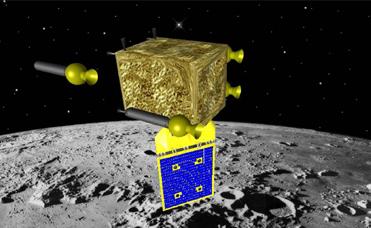
Artist's concept of the MoonLITE mission. British National Space Centre (BNSC)
LONDON (BNS): Britain is expected to launch its own probe to the moon to explore causes of mysterious moonquakes, a British paper has reported.
MoonLITE or the Moon Lightweight Interior and Telecommunications Experiment would be a 100 million pound unmanned mission, the Daily Telegraph reported. Its main aim would be to study factors that cause quakes that vibrate through the lunar rock.
The paper claimed that country's science minister Lor Drayson is expected to announce the mission next month. The scientists have planned for the launch somewhere between 2012 and 2014. MoonLITE is backed by NASA.
MoonLITE is a small robotic mission (of less than one tonne at launch) to the Moon. It comprises a polar orbiter and multiple instrumented penetrator vehicles. The penetrators would emplace a global network of three to four 13-kilogram science stations equipped with seismometers, heat sensors, and spectrometers and powered by primary batteries. Both orbiter and surface stations have a nominal one-year life.
Apart from the moonquake, the probe would explore the chemical composition of the rocks and search water on the moon's surface. The phenomenon of moonquakes has long intrigued scientists, as unlike earth, moon does not seem to have tectonic plates. Earthquakes are attributed to the shifting of huge tectonic plates.
"The moon still holds an awful lot of secrets. Most of what we know about the moon is from a relatively small area on the nearside of the moon and we have no samples or data from the far side," the daily quoted Ian Crawford, from the school of Earth Sciences at Birkbeck College, University of London.
Crawford is one of the scientists who first proposed the MoonLITE mission, said the paper, which would fire four suitcase-sized penetrator probes into different points around the lunar surface.
If successful Britain would join a band of successful countries to have launched a lunar probe. The fact that India is ahead of Britain speaks volumes about India’s Chandrayaan-1. The British media has hailed the Indian mission as a triumph of India's scientific abilities.
"India has joined China and Japan in taking seriously the importance of venturing beyond Earth, and the lunch of Chandrayaan-1 makes a forceful declaration. The first, and most trivial, is that the very existence of a space programme is a matter of national pride. The rivalry between America and the Soviet Union during the rocket launches of the 1950s and 1960s was the most evident example of this, and part of the reason why many people still think that the exploration of space is a waster of time and money," wrote the Telegraph of UK after Chandrayaan-1 launch. Lauding India's effort, the paper had remarked that India has set it sight beyond the mundane.
 Previous Article
Previous Article Next Article
Next Article













The Indian Air Force, in its flight trials evaluation report submitted before the Defence Ministry l..
view articleAn insight into the Medium Multi-Role Combat Aircraft competition...
view articleSky enthusiasts can now spot the International Space Station (ISS) commanded by Indian-American astr..
view article